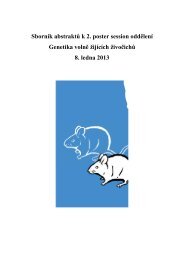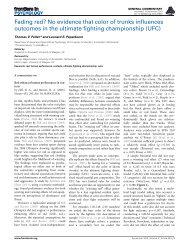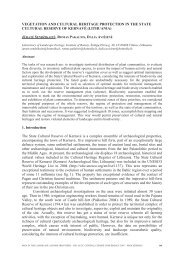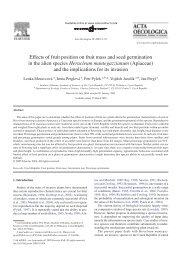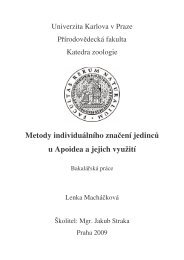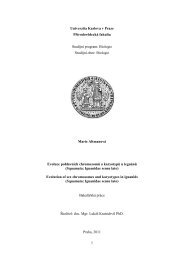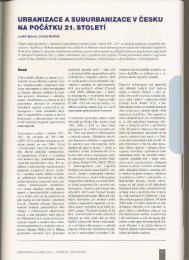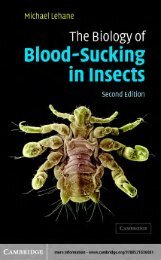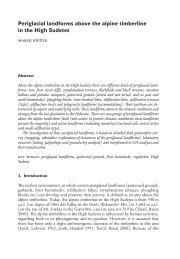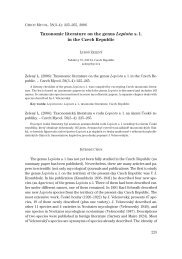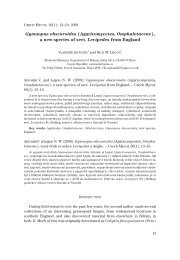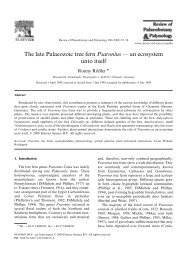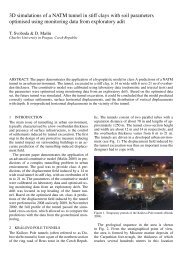Sarcoporia polyspora and Jahnoporus hirtus: two rare polypores ...
Sarcoporia polyspora and Jahnoporus hirtus: two rare polypores ...
Sarcoporia polyspora and Jahnoporus hirtus: two rare polypores ...
You also want an ePaper? Increase the reach of your titles
YUMPU automatically turns print PDFs into web optimized ePapers that Google loves.
CZECH MYCOL. 61(2): 187–195, 2010<br />
<strong>Sarcoporia</strong> <strong>polyspora</strong> <strong>and</strong> <strong>Jahnoporus</strong> <strong>hirtus</strong>: <strong>two</strong> <strong>rare</strong><br />
<strong>polypores</strong> collected in South Bohemia, Czech Republic<br />
JOSEF VLASÁK 1, 2 <strong>and</strong> JIŘÍ KOUT 3<br />
1 Biology Centre of the Academy of Sciences of the Czech Republic, Inst. Plant Mol. Biol., Branišovská<br />
31, CZ-370 05 České Budějovice, Czech Republic;<br />
vlasak@umbr.cas.cz<br />
2 University of South Bohemia, Faculty of Science, Branišovská 31, CZ-370 05 České Budějovice,<br />
Czech Republic<br />
3<br />
University of West Bohemia, Faculty of Education, Klatovská 51, CZ-306 19 Plzeň, Czech Republic;<br />
martial@seznam.cz<br />
Vlasák J. <strong>and</strong> Kout J. (2010): <strong>Sarcoporia</strong> <strong>polyspora</strong> <strong>and</strong> <strong>Jahnoporus</strong> <strong>hirtus</strong>: <strong>two</strong><br />
<strong>rare</strong> <strong>polypores</strong> collected in South Bohemia, Czech Republic. – Czech Mycol. 61(2):<br />
187–195.<br />
Two very <strong>rare</strong> <strong>polypores</strong> are reported from the Czech Republic: <strong>Sarcoporia</strong> <strong>polyspora</strong>, for the first<br />
time, <strong>and</strong> <strong>Jahnoporus</strong> <strong>hirtus</strong>, for the second time. Several basidiocarps of both <strong>polypores</strong> were collected<br />
<strong>and</strong> their growth <strong>and</strong> development were monitored for a period of three months. The collections<br />
<strong>and</strong> localities are described <strong>and</strong> their world distribution as well as affinities with other fungi are commented.<br />
Key words: Parmastomyces transmutans, Albatrellus, Polyporales, Czech Republic.<br />
Vlasák J. a Kout J. (2010): <strong>Sarcoporia</strong> <strong>polyspora</strong> a <strong>Jahnoporus</strong> <strong>hirtus</strong>: dva vzácné<br />
druhy chorošů nalezené v jižních Čechách. – Czech Mycol. 61(2): 187–195.<br />
Byly nalezeny dva velmi vzácné choroše: <strong>Sarcoporia</strong> <strong>polyspora</strong> je hlášena z České republiky vůbec<br />
poprvé, <strong>Jahnoporus</strong> <strong>hirtus</strong> podruhé. V obou případech bylo sbíráno několik plodnic a jejich růst a vývin<br />
byl sledován po dobu tří měsíců. Nalezené houby a lokality jsou popsány a krátce je diskutována taxonomie<br />
a celosvětové rozšíření obou druhů.<br />
INTRODUCTION<br />
Two extremely <strong>rare</strong>, but conspicuous <strong>and</strong> for their ever abundant <strong>and</strong> unique<br />
basidiospores hardly mistakable <strong>polypores</strong>, were collected close to Hluboká nad<br />
Vltavou. The find of <strong>Sarcoporia</strong> <strong>polyspora</strong> (syn. Parmastomyces transmutans)<br />
was the first in the Czech Republic, <strong>Jahnoporus</strong> <strong>hirtus</strong> (syn. Albatrellus <strong>hirtus</strong>)<br />
was found for the second time. J. <strong>hirtus</strong> was in fact collected several times at<br />
three different sites. The most important characteristics of both fungi <strong>and</strong> their localities<br />
are described, <strong>and</strong> their world distribution is shortly commented. Also, the<br />
complicated history of their identification <strong>and</strong> description is given.<br />
187
MATERIAL AND METHODS<br />
Specimens studied<br />
<strong>Sarcoporia</strong> <strong>polyspora</strong>: Czech Republic, South Bohemia, Hluboká nad<br />
Vltavou – Purkarec, Karlův Hrádek Ruins, 375 m a. s.l. , 49° 6' 45" N, 14° 36' 42" E,<br />
Picea abies log, 2 Aug 2009, leg. et det. J. Vlasák, private herbarium J. Vlasák<br />
JV0908/4b,c (duplicate in National Museum, Prague, PRM 915663); ibid., 11 Aug<br />
2009 (JV0908/15b,c; duplicate PRM 915664); ibid., 16 Aug 2009 (JV0908/20); ibid., 1<br />
Sep 2009 (JV0909/1). The locality of Karlův Hrádek Ruins is a warm, open forest,<br />
on a steep bank of the Vltava River, predominantly with oak, occasionally pine,<br />
spruce <strong>and</strong> beech. The whole area is based on acid soil.<br />
<strong>Jahnoporus</strong> <strong>hirtus</strong>: Czech Republic, South Bohemia, Hluboká nad<br />
Vltavou – Libochovka Nature Reserve, 425 m a. s. l., 49° 4' 44" N, 14° 29' 17" E,<br />
Picea abies log, 15 Aug 2009, leg. et det. J. Vlasák, private herbarium J. Vlasák<br />
JV0908/16a (duplicate in National Museum, Prague, PRM 915665); ibid., Picea<br />
abies stump No. 1, 27 Sep 2009, JV0909/35, ibid., 11 Oct 2009, JV0910/4 (duplicate<br />
in National Museum, Prague, PRM 915959); ibid., Picea abies stump No. 2, 11 Oct<br />
2009, JV0910/5. Libochovka Nature Reserve is a deep valley with preserved remnants<br />
of an old-growth beech forest with sporadic fir <strong>and</strong> minor spruce st<strong>and</strong>s of<br />
over 200 years old. It is a part of the Nová obora game park.<br />
Microscopic characters were observed in Melzer’s reagent <strong>and</strong> in 5 % KOH under<br />
an Olympus BX41 microscope, using an oil immersion lens.<br />
RESULTS<br />
<strong>Sarcoporia</strong> <strong>polyspora</strong> P. Karst. 1894 Figs. 1–3<br />
= Parmastomyces transmutans (Overh.) Ryvarden & Gilb. 1984<br />
D e s c r i p t i o n (based on the collection cited above). Basidiocarps annual,<br />
resupinate to effused-reflexed, margin forming pileus at first adnate, up to 0.7 cm<br />
thick, later pileus reflexed up to 1 cm, laterally elongated up to 20 cm, soft <strong>and</strong><br />
fleshy, drying brittle; upper surface of pileus at first white with ochre or reddish<br />
tints, bruised <strong>and</strong> drying reddish brown, matted-strigose; pore surface white, after<br />
bruising turning very slowly (5 min.) reddish brown, on drying greyish, locally<br />
with ochre tints, pores circular, 2–4 per mm, tube layer fragile, brittle <strong>and</strong> pulverising<br />
easily when dry, 5 mm thick; context white, soft, with about 3 mm thick,<br />
darker gelatinous layer under the tubes, which is sometimes dispersed into a number<br />
of resinous drops or streaks <strong>and</strong> forms a thin dark line in the context after drying.<br />
Spore print white.<br />
188<br />
CZECH MYCOL. 61(2): 187–195, 2010
VLASÁK J. AND KOUT J.: SARCOPORIA POLYSPORA AND JAHNOPORUS HIRTUS: TWO RARE POLYPORES<br />
Fig. 1. <strong>Sarcoporia</strong> <strong>polyspora</strong>, young basidiocarp, 11 Aug 2009 (JV0909/1). Photo by J. Vlasák.<br />
Fig. 2. <strong>Sarcoporia</strong> <strong>polyspora</strong>, old basidiocarp, 1 Sep 2009 (JV0909/1). Photo by J. Vlasák.<br />
189
Hyphal system monomitic with thin to thick-walled, frequently branched<br />
hyphae with clamps. Cystidia none, basidia clavate, 4-sterigmate, 20–25 × 5–6 μm.<br />
Spores always very abundant, ellipsoid, slightly bent, smooth, hyaline, somewhat<br />
thick-walled, strongly dextrinoid, 4–6 × 2–2.8 μm (Fig. 3). Causes brown cubical<br />
rot; yet it shows a positive reaction to phenolic oxidases.<br />
Substrate <strong>and</strong> habitat.Ona5mlong top part of a spruce (Picea abies)<br />
log, lying on soil. The log had been monitored for about 15 years; its lower part decayed<br />
<strong>and</strong> pulverised a long time ago, but its top had always remained surprisingly<br />
hard, even when moss-covered <strong>and</strong> with pulverised sap-wood, <strong>and</strong> no <strong>polypores</strong><br />
had ever appeared on it. On 7 Jul 2009 we noted several basidiocarps about 10 cm<br />
long on both sides of the log. The basidiocarps grew here until the end of September<br />
eventually changing to a brown, dry <strong>and</strong> disintegrating pellicle.<br />
D i s t r i b u t i o n. This is the first collection of S. <strong>polyspora</strong> in the Czech Republic.<br />
In Europe, it is a very <strong>rare</strong> species. Ryvarden <strong>and</strong> Gilbertson (1994) collected<br />
data on its occurrence in ten countries only, most of them situated in the Mediterranean<br />
<strong>and</strong> Northern Europe. A few other countries could be added to the list according<br />
to recent reports (Gyosheva et al. 2006, Westerberg 2006). From the Central<br />
European region it is known only from Pol<strong>and</strong> (Ryvarden <strong>and</strong> Gilbertson<br />
1994, as Parmastomyces transmutans). Several collections were reported from<br />
the Asian part of Russia (Kotiranta 1998) <strong>and</strong> China (Dai 1996, Dai <strong>and</strong> Penttila<br />
2006), <strong>and</strong> it was also found in Algeria, northern Africa (Maire 1945). On the other<br />
h<strong>and</strong>, it is a common species in North America, where it is known from Ontario,<br />
Canada <strong>and</strong> from many localities in the USA (Kotiranta 1998, Gilbertson <strong>and</strong><br />
Ryvarden 1987).<br />
N o t e s. This soft polypore with reddish tints after drying or bruising looks<br />
very much like Oligoporus fragilis (Fr.) Gilb. & Ryvarden <strong>and</strong> O. leucomallellus<br />
(Murrill) Gilb. & Ryvarden, but its ellipsoid, slightly bent, thick-walled <strong>and</strong><br />
190<br />
CZECH MYCOL. 61(2): 187–195, 2010<br />
Fig. 3. Basidiospores of <strong>Sarcoporia</strong> <strong>polyspora</strong> (A) <strong>and</strong> <strong>Jahnoporus</strong> <strong>hirtus</strong> (B).
VLASÁK J. AND KOUT J.: SARCOPORIA POLYSPORA AND JAHNOPORUS HIRTUS: TWO RARE POLYPORES<br />
dextrinoid spores (Fig. 3) are quite unique in <strong>polypores</strong>. Macroscopically, it is<br />
characterised by the thick gelatinous layer in the context that is best seen after<br />
ripping the pileus apart. Also, the pilei were only narrowly reflexed in our material<br />
<strong>and</strong> much smaller than in most O. fragilis collections, <strong>and</strong> the colour change in<br />
the first minutes after bruising was much slower <strong>and</strong> without yellowish tones.<br />
We know S. <strong>polyspora</strong> very well from the USA where it grows abundantly,<br />
most often on pines (Gilbertson <strong>and</strong> Ryvarden 1987, Vlasák 2004). It occurs in the<br />
USA also on hardwoods, especially on Prunus serotina, on which it forms very<br />
thick, soft basidiocarps that look quite different, but the spores are determining.<br />
P. A. Karsten (1894) described S. <strong>polyspora</strong> already in the 19 th century but this<br />
name has been ab<strong>and</strong>oned for years. Niemelä et al. (2005) only recently revised<br />
Karsten’s type material <strong>and</strong> discovered the true identity of the type of <strong>Sarcoporia</strong><br />
<strong>polyspora</strong>. Meanwhile, a number of other names had been used for this fungus.<br />
R. Maire described the species from North Africa in 1945 as Tyromyces mollissimus<br />
(Pouzar 1984), but the type material was lost <strong>and</strong> so this name was never fully accepted.<br />
From the USA, L. O. Overholts (1941) described the species as Polyporus<br />
subcartilagineus without a Latin diagnosis, <strong>and</strong> later again (thick specimen from<br />
black cherry) as Polyporus transmutans (Overholts 1952). Independently, based<br />
on collections from Estonia <strong>and</strong> Siberia, it was described by Parmasto (1957) as<br />
Tyromyces kravtzevianus Bondartsev & Parmasto. Kotlaba <strong>and</strong> Pouzar (1964)<br />
created the genus Parmastomyces for this unique polypore <strong>and</strong> the name P. transmutans<br />
was mostly used until recently.<br />
The affinities of the monotypic genus <strong>Sarcoporia</strong> with other polypore genera<br />
are unclear. Basidiocarps, hyphae <strong>and</strong> brown rot suggest a similarity with<br />
Oligoporus (Postia) species but the spores are very different. Ryvarden <strong>and</strong><br />
Gilbertson (1994) speculate that it belongs to the Coniophoraceae family, because<br />
of the similar spores. The phylogenetic analysis by Hibbet <strong>and</strong> Binder (2002)<br />
based primarily on the sequence of rather conserved 18S rDNA could not confirm<br />
or refute any of these hypotheses because of a small species set. P. transmutans<br />
remained rather isolated in their phylogenetic tree. The more variable sequence of<br />
28S rDNA present in the GenBank shows highest similarity (97 %) with Amylocystis<br />
lapponica (Romell) Bondartsev & Singer, which makes sense, as the <strong>two</strong> species<br />
are quite similar, bruising <strong>and</strong> drying reddish brown, both cause brown rot <strong>and</strong><br />
some of their microstructures stain in Melzer’s reagent.<br />
<strong>Jahnoporus</strong> <strong>hirtus</strong> (Quél.) Nuss 1980 Figs. 3–5<br />
D e s c r i p t i o n (based on the collections cited above). Basidiocarps annual,<br />
stipitate, very variable: six out of the seven basidiocarps found were spathulate to<br />
laterally stipitate <strong>and</strong> one had a more or less central stipe. Stipe 1–2 cm long <strong>and</strong><br />
1–2 cm in diam., with signs of branching from the base, pileus 3–10 cm in diam.,<br />
191
upper surface of pileus <strong>and</strong> stipe greyish to tan, azonate, hispid, tube layer white,<br />
continuous with the context, decurrent on stipe, sometimes to its very base, 5 mm<br />
thick, pores white, angular, labyrinthic in older basidiocarps, 1–2 per mm, with entire<br />
or somewhat lacerate dissepiments. Taste bitter.<br />
Hyphal system monomitic, tramal hyphae thin-walled with clamps, contextual<br />
hyphae often somewhat thick-walled, with inflated parts, 5–13 μm in diam.<br />
Cystidia absent, basidia clavate, very large, 38–43 × 8–11 μm, with swollen sterigmata.<br />
Basidiospores abundant, fusiform with distinctly narrowed ends, slightly bent towards<br />
apiculus, smooth, negative in Melzer’s reagent, very large, 12–15 × 4–5 μm<br />
(Fig. 3).<br />
Substrate <strong>and</strong> habitat.Thefirst specimen was collected in August under<br />
a big spruce log lying in a somewhat muddy basin for about 15 years. The log had<br />
been monitored since the live tree was broken at the base in 1994. No remarkable<br />
<strong>polypores</strong> had ever appeared on it. At present (year 2009), it is covered with many<br />
basidiocarps of Ischnoderma benzoinum, Oligoporus balsameus <strong>and</strong> Gloeophyllum<br />
odoratum – a typical population of <strong>polypores</strong> on these kind of live-fallen logs in<br />
Libochovka Nature Reserve. No other basidiocarp appeared here in the following<br />
<strong>two</strong> months, but at the end of September, another site was discovered at about<br />
100 m distance in a nearby wild boar enclosure, on a strongly rotten, disintegrated<br />
spruce stump of about twenty years old. Three basidiocarps grew on it but <strong>two</strong> of<br />
them were already highly decayed so that only the youngest one was collected.<br />
Two weeks later, a new <strong>and</strong> large basidiocarp was found here which was already<br />
rather old (Fig. 4), <strong>and</strong> another one grew on a nearby stump, 10 m from the former<br />
(Fig. 5). We infer from this that the fruitbodies of <strong>Jahnoporus</strong> <strong>hirtus</strong> develop<br />
quickly.<br />
D i s t r i b u t i o n. This polypore is known from the USA (Gilbertson <strong>and</strong><br />
Ryvarden 1986), Far East Asia (Dai et al. 2009) <strong>and</strong> Europe but everywhere, especially<br />
in Europe (Jahn 1973), it is very <strong>rare</strong>. It grows on stumps <strong>and</strong> logs of fir <strong>and</strong><br />
spruce in Europe (Jahn 1973), in the USA <strong>and</strong> Asia it also occurs on other conifers<br />
(Gilbertson <strong>and</strong> Ryvarden 1986) or hardwoods (Dai et al. 2009). In the Czech Republic,<br />
it was earlier collected in Polom Nature Reserve, Železné hory Mts. in<br />
1987, <strong>and</strong> this was reputedly only the sixth collection from Europe (Antonín et al.<br />
1989). We have not learned of any other finds in Europe since then. The three sites<br />
at the locality where this fungus had never appeared before suggest, however, that<br />
the species may not be so <strong>rare</strong>. Perhaps, it needs special environmental conditions<br />
for basidiocarp development that were met just that year.<br />
N o t e s. This strange fungus was described by Quélet (1873: 356) from the Jura<br />
Mts. around Neuchâtel, Switzerl<strong>and</strong>, as Polyporus <strong>hirtus</strong>. In the course of years,<br />
the species has been transferred to several polypore genera (Jahn 1973) but the<br />
most appropriate seemed to be the combination Albatrellus <strong>hirtus</strong> (Quél.) Donk<br />
(1971), as this species reminds Albatrellus very much in its fleshy, stipitate, annual<br />
192<br />
CZECH MYCOL. 61(2): 187–195, 2010
VLASÁK J. AND KOUT J.: SARCOPORIA POLYSPORA AND JAHNOPORUS HIRTUS: TWO RARE POLYPORES<br />
Fig. 4. <strong>Jahnoporus</strong> <strong>hirtus</strong> (JV0910/4). Photo by J. Vlasák.<br />
Fig. 5. <strong>Jahnoporus</strong> <strong>hirtus</strong> (JV0909/5). Photo by J. Vlasák.<br />
193
asidiocarps <strong>and</strong> white, monomitic context. Yet, it differs in growing on wood,<br />
having a hirsute stipe <strong>and</strong> pileus, bitter taste <strong>and</strong> very different basidiospores. Accordingly,<br />
Nuss (1980) established the monotypic genus <strong>Jahnoporus</strong> for this species<br />
in honour of H. Jahn, who first treated this species in detail in one of his papers<br />
(Jahn 1973). Nuss (1980) stressed that <strong>Jahnoporus</strong> context overgrows small<br />
twigs <strong>and</strong> debris deposited on the pileus surface in contrast to Albatrellus, but inspecting<br />
our specimens we could not see any signs of such overgrowing.<br />
rDNA ITS1 <strong>and</strong> ITS2 sequences of <strong>two</strong> <strong>Jahnoporus</strong> <strong>hirtus</strong> collections from the<br />
USA are in the GenBank <strong>and</strong> they are nearly identical. The Albatrellus ovinus sequence<br />
is the most similar but still very different (84 % similarity), indicating only<br />
a low level of kinship. One of the published sequences of J. <strong>hirtus</strong> is annotated as<br />
an “attempt to split Albatrellus sensu lato to be published in 2009”, but nothing<br />
has been published yet.<br />
DISCUSSION<br />
The first half of the year 2009 was very rainy around Hluboká nad Vltavou,<br />
South Bohemia, Czech Republic. Compared to 2007 <strong>and</strong> 2008, the precipitation<br />
rate in 2009 was twice as high, close to the 100-year maximum, according to data<br />
of the Czech Hydrometeorological Institute. This is perhaps the reason why some<br />
<strong>rare</strong> fungi appeared for the first time at otherwise well-known localities. Both <strong>rare</strong><br />
<strong>polypores</strong> were collected by the first author on spruce logs that had been inspected<br />
regularly for about fifteen years, three to four times a year, with negative<br />
result. Many other <strong>rare</strong> <strong>polypores</strong> such as Rhodonia placenta, Oligoporus<br />
cerifluus <strong>and</strong> Antrodia gossypium, which were observed there in the past but<br />
had not been seen for several years, appeared in 2009 as well. We may wonder<br />
which other <strong>rare</strong> or perhaps unknown fungi grow concealed in the wood-mass of<br />
old trees at these localities protected since the early Middle Ages as game l<strong>and</strong>s of<br />
the aristocratic l<strong>and</strong>owners <strong>and</strong> were only in the past few decades shattered <strong>and</strong><br />
spoilt by production forest management. This is probably a too optimistic view,<br />
but just the prospect of it exhilarated us a lot, in the summer of 2009.<br />
194<br />
CZECH MYCOL. 61(2): 187–195, 2010<br />
ACKNOWLEDGEMENT<br />
We wish to thank Petr Vampola (Smrčná, Czech Republic) for valuable comments.
VLASÁK J. AND KOUT J.: SARCOPORIA POLYSPORA AND JAHNOPORUS HIRTUS: TWO RARE POLYPORES<br />
REFERENCES<br />
ANTONÍN V., ČERNÝ A., MANN J. <strong>and</strong> VALTER J. (1989): Albatrellus <strong>hirtus</strong> (Cooke) Donk found in<br />
Czechoslovakia. – Česká Mykol. 43: 61–64. (in Czech)<br />
DAI Y. C. (1996): Changbai wood-rotting fungi 7. A checklist of the <strong>polypores</strong>. – Fung. Sci. 11: 79–105.<br />
DAI Y. C. <strong>and</strong> PENTTILA R. (2006): Polypore diversity of Fenglin Nature Reserve, northeastern China. –<br />
Ann. Bot. Fennici 43: 81–96.<br />
DAI Y. C., YUAN H.-S., WANG H.-C., YANG F. <strong>and</strong> WEI Y.-L. (2009): Polypores (Basidiomycota) from Qin<br />
Mts. in Shaanxi Province, central China. – Ann. Bot. Fennici 46: 54–61.<br />
DONK M. A. (1971): Notes on European <strong>polypores</strong> VI. – Verh. Koninkl. Nederl. Akad. Wet., Ser. C, 74:<br />
3–4.<br />
GILBERTSON R. L. <strong>and</strong> RYVARDEN L. (1986): North American Polypores, Vol. 1. Abortiporus – Lindtneria.<br />
– 408 p. Oslo.<br />
GILBERTSON R. L. <strong>and</strong> RYVARDEN L. (1987): North American Polypores, Vol. 2. Megasporoporia – Wrightoporia.<br />
– 506 p. Oslo.<br />
GYOSHEVA M. M., DENCHEV C. M., EVTIMIA G. DIMITROVA E. G., ASSYOV B., PETROVA R. D. <strong>and</strong> STOICHEV<br />
G. T. (2006): Red List of fungi in Bulgaria. – Mycol. Balcan. 3: 81–87.<br />
HIBBET D. S. <strong>and</strong> BINDER M. (2002): Evolution of complex fruiting-body morphologies in homobasidiomycetes<br />
– Proc. R. Soc. Lond. B 269: 1963–1969.<br />
JAHN H. (1973): Albatrellus <strong>hirtus</strong> (Quél.) Donk, Rauher Scharfporling. – Schw. Z. Pilzk. 51: 104–108.<br />
KARSTEN P. A. (1894): Fragmenta mycologica XLII. – Hedwigia 33: 15–16.<br />
KOTIRANTA H. (1998): Parmastomyces mollissimus in North Europe. – Folia Cryptog. Estonica 33:<br />
41–47.<br />
KOTLABA F. <strong>and</strong> POUZAR Z. (1964): Staining spores of Homobasidiomycetes in cotton blue <strong>and</strong> its importance<br />
for taxonomy. – Feddes Repert. 69: 131–142.<br />
LOWE J. L. (1956): Type studies of the <strong>polypores</strong> described by Karsten. – Mycologia 48: 270–276.<br />
MAIRE R. (1945): Etudes mycologiques. Fascicle 5. – Bull. Soc. Hist. Nat. Afr. N. 36: 24–42.<br />
NIEMELÄ T., KINNUNEN J., LARSSON K. H., SCHIGEL D. S. <strong>and</strong> LARSSON E. (2005): Genus revisions <strong>and</strong><br />
new combinations of some North European <strong>polypores</strong>. – Karstenia 45: 75–80.<br />
NUSS I. (1980): Untersuchungen zur systematischen Stellung der Gattung Polyporus. – Hoppea 39:<br />
127–198.<br />
OVERHOLTS L. O. (1941): New species of Polyporaceae. – Mycologia 33: 90–102.<br />
OVERHOLTS L. O. (1952): New species of <strong>polypores</strong>. – Mycologia 44: 224–227.<br />
PARMASTO E. (1957): Mycotheca Estonica 1, 22 (No. 25).<br />
POUZAR Z. (1984): Notes on four European <strong>polypores</strong>. – Česká Mykol. 38: 203–204.<br />
QUÉLET L. (1873): Les Champignons du Jura et des Vosges. – Mém. Soc. Émul. Montbéliard, Sér. 2, 5:<br />
333–427.<br />
RYVARDEN L. <strong>and</strong> GILBERTSON R. L. (1994): European Polypores, Part 2. Meripilus – Tyromyces. – 743<br />
p. Oslo.<br />
VLASÁK J. (2004): Hledání chorošů v USA (Collecting <strong>polypores</strong> in the USA). – Mykol. Listy 90–91:<br />
15–19. (in Czech)<br />
WESTERBERG S. (2006): En för l<strong>and</strong>et ny vedsvamp påträffad i Norrbotten. – Svensk Mykologisk<br />
Tidskrift 27: 71–73.<br />
195



